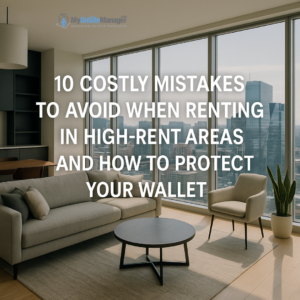Living in a high-rent city can feel like a dream access to jobs, entertainment, culture, and opportunities that smaller markets just can’t match. But with high demand comes high prices, and many renters find themselves struggling to keep up with unexpected costs or bad lease decisions.
The truth is, your rent is just one piece of the puzzle. In cities like New York, San Francisco, Los Angeles, and even fast-growing metros like Austin or Miami, it’s easy to make mistakes that lead to overspending, stress, or regret. To help you make smarter housing choices, here are 10 costly mistakes renters should avoid in high-rent areas and strategies to protect yourself.
1. Skipping the Fine Print in Your Lease
One of the biggest mistakes renters make is signing a lease too quickly. Buried in those pages might be details about:
-
Pet policies (extra rent or deposits)
-
Trash, parking, or amenity fees
-
Severe penalties for breaking the lease early
Tip: Always request a digital copy of the lease in advance and take time to review it line by line. If something feels unclear, ask your landlord or property manager before signing.
2. Falling for “Too Good to Be True” Deals
In high-demand rental markets, scams are everywhere. Fake listings often feature beautiful photos, below-market rent, and a landlord who “can’t meet in person.”
Tip: Never transfer money before seeing a property. Meet in person or request a live video tour, and verify the landlord’s identity through public property records if possible. If it feels off, it probably is.
3. Underestimating Utility Costs
That trendy loft downtown may look affordable on paper until your utility bills arrive. Older buildings with poor insulation, outdated appliances, or high heating/cooling demands can double or triple your monthly expenses.
Tip: Ask the landlord or past tenants for an estimate of monthly utilities. Apps like UtilityScore can also give you a ballpark figure based on the property’s age and size.
4. Neglecting Commuting Expenses
A cheaper apartment far from work or school might backfire once you factor in gas, train passes, or lost time in traffic. A two-hour commute can drain both your wallet and your energy.
Tip: Use mapping tools to calculate the time and cost of commuting daily. Sometimes paying slightly higher rent closer to work is actually the more economical choice.
5. Skipping Renter’s Insurance
Many renters mistakenly believe their landlord’s insurance covers their belongings it doesn’t. Without renter’s insurance, you’re vulnerable to losses from theft, fire, water damage, or even accidents in your unit.
Tip: For as little as $10–$20 per month, renter’s insurance can protect thousands of dollars’ worth of belongings. It’s one of the smartest financial safety nets you can have.
6. Ignoring the Neighborhood Vibe
An apartment is more than four walls it’s the community around it. Noise levels, safety, amenities, and access to groceries or public transport can make or break your experience.
Tip: Visit the neighborhood at different times (day, night, weekends) before committing. Check community forums or apps like Nextdoor to learn about safety and quality of life.
7. Overspending on Brand-New Furniture
When moving into a new place, it’s tempting to splurge on furniture. But in high-rent areas, where mobility is common, new furniture can become a financial burden if you move again in a year.
Tip: Consider secondhand marketplaces like Facebook Marketplace, Craigslist, or OfferUp. You can find high-quality pieces for a fraction of the cost.
8. Forgetting About Move-In and Hidden Fees
Rent isn’t your only upfront expense. You may face application fees, broker fees, deposits, and even move-in elevator charges in large apartment complexes.
Tip: Ask for a full list of move-in costs upfront. According to Zillow, median security deposits in the U.S. were around $700, but in high-rent cities, they can be several times higher.
9. Locking Into a Long Lease Without Flexibility
While a two-year lease may seem stable, it can become a financial trap if your job changes, your roommate moves out, or rent prices drop in your area.
Tip: Consider shorter lease terms or negotiate for early-termination clauses. Paying a slightly higher rent for flexibility can save you money in the long run.
10. Not Negotiating Rent or Terms
Many renters assume rent is non-negotiable, but landlords may be willing to compromise especially if you have a strong application.
Tip: Offer to sign a longer lease, move in sooner, or pay several months upfront to negotiate a discount. Even $50 off per month saves $600 a year.
Final Thoughts
High-rent areas can be overwhelming, but with smart planning, you can avoid costly pitfalls. Remember to:
- Review leases carefully
- Verify listings to avoid scams
- Budget for hidden and recurring costs
- Protect yourself with renter’s insurance
- Negotiate whenever possible
Renting is not just about securing a roof over your head it’s about creating stability, protecting your finances, and ensuring your lifestyle matches your environment. With these tips, you’ll be better equipped to thrive in even the most expensive rental markets.
Source: 10 Costly Mistakes You Should Not Make in High-Rent Areas (MSN)

